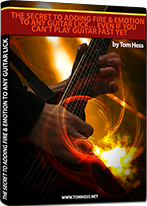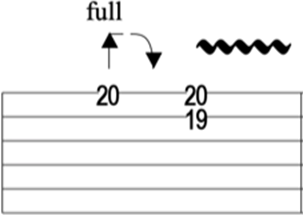How To Use Musical Tension In Your Guitar Licks And Guitar Solos
Emotion To Any Guitar Lick

EMAIL TO GET ACCESS
By submitting your info, you agree to send it to Tom Hess Music Corporation who will process and use it according to their privacy policy.
Musical dissonance is a no-no in guitar solos – right?
Wrong!
When you know what you’re doing...
...you can use musical dissonance to create extremely emotional guitar solos and breathe life into your guitar playing.
But there is a caveat:
You’d better know how to use musical dissonance like the pros do.
What does that mean?
It means knowing how to control musical dissonance.
(i.e. using it deliberately instead of at random.)
Emotion To Any Guitar Lick

EMAIL TO GET ACCESS
By submitting your info, you agree to send it to Tom Hess Music Corporation who will process and use it according to their privacy policy.
It also means:
milking the musical tension dissonance creates in your lead guitar playing to its utmost (I’ll show you how below).
Plus, it means resolving the musical tension you created smoothly and seamlessly.
Want to see how to do this in your guitar solos?
Watch this video and I’ll show you:
Here are a few more tips for using musical tenion creatively in your lead guitar playing and become a more expressive musician:
Tip #1 For Using Dissonance In Guitar Solos: Use Guitar Scales That Are Easy To Build Musical Tension With
This may sound surprising, but if you want to maximize musical tension in your guitar licks and guitar solos when you play lead guitar…
… my advice is to avoid the (blues) pentatonic scale.
Yes, I said the blues pentatonic scale.
Possibly the most famous lead guitar scale of all time. The scale many people try to use to create emotional guitar licks and lead guitar solos.
Why avoid this scale?
Because the (standard) pentatonic scale is missing the most important musical interval for creating musical dissonance and building musical tension.
I'm talking about half steps.
Guitar solos that don’t contain half steps sounds way less dramatic (and have less musical tension) than guitar licks and guitar solos with half steps.
That said, three are some pentatonic scales that do contain half steps (and thus make it possible to insert incredible dissonance into your guitar solos).
My favorite pentatonic scale is: the Hirajoshi scale.
The Hirajoshi scale is a 5-note (i.e. pentatonic) scale from Japan.
And just like the standard pentatonic (blues) scale everyone knows, it also has 5 box shapes.
But unlike guitar licks made from the standard pentatonic scale...
...you can easily use it to create guitar licks full of musical dissonance and musical tension. (Because this scale has several half steps.)
(Plus: its unique may help you develop a more creative lead guitar style, if that is your goal.)
Check out the video below to see & hear the Hirajoshi scale shapes in action:
Tip: Here is how you can milk more musical tension from all guitar licks you play in your guitar solos:
Find the chords (in the chord progression you’re soloing over) that contain the most drama and tension. Then insert the most musical dissonance into the guitar licks when playing over those chords.
This way the musical dissonance in your guitar licks will be amplified by the musical tension in the chords you are playing lead guitar over.
This guitar solo video shows you how.
Another tip: to make it easy to milk all the musical dissonance in the Hirajoshi scales – learn ALL 5 of its box patterns. Then practice creating guitar licks and lead guitar solos from all 5 scale shapes.
The more you can see the guitar neck as one giant scale shape as you play your guitar licks and lead guitar solos – the more free you’ll be to use and control musical dissonance.
Tip #2 For Using Dissonance In Guitar Solos: Play Guitar Licks Using Exotic Scales
When it comes to musical tension and dissonance in guitar solos… one scale stands out above all others.
It is, in my opinion, the saddest, most dramatic & most emotional guitar scale ever.
This scale contains so much musical tension, it’s almost impossible to play lead guitar solos from it without feeling strong longing, sadness or melancholy.
That scale is the Mixolydian b6. (Its technical name is the 5th mode of melodic minor.)
Want to see how it sounds and how to easily use this scale to create dissonance in guitar solos and licks?
Watch this video:
Another great guitar scale that’s perfect for creating guitar licks and using dissonance in guitar solos is the Lydian scale.
This scale is a favorite of the great lead guitar masters Steve Vai and Joe Satriani.
I also enjoy using the Lydian scale to create, milk and resolve dissonance in guitar solos.
Check out this video to see how the Lydian scale sounds and hear the amazing musical tension you can build with it:
Question: “Tom Hess, which guitar scale is better for creating guitar licks with musical tension and using dissonance in guitar solos? The Hirajoshi scale, the 5th mode of melodic minor or the Lydian scale?
Answer: All 3 of these lead guitar scales are great in their own way. You can create lead guitar licks and guitar solos with a ton of musical dissonance and build a lot of musical tension using all 3. That said, all 3 lead guitar scales sound different.
For example:
The Hirajoshi scale is a lot more in-your-face and aggressive. Its half steps (between notes 2 and b3, as well as between 5 and b6) can be used to inject your lead guitar licks and guitar solos with that feeling. (And any musical tension you create with the Hirajoshi scale will have a tint of that intensity about it.)
The Lydian scale has a very cool dreamy and floating feel. And that makes the Lydian scale the ideal choice for guitar licks and lead guitar solos that require that feeling.
Some of the musical tension present in the Lydian scale comes from hearing its unexpected #4 note where you expect to hear the regular 4th note of the major scale.
Mixolydian b6 scale is (in my opinion) the most emotional and melancholic guitar scale. So, I use it (instead of the Lydian scale or the Hirajoshi scale) in guitar licks and guitar solos that require that feel.
But all 3 scales can inject your lead guitar playing with beautiful musical dissonance and musical tension.
Tip #3 For Using Dissonance In Guitar Solos: Use String Bending To Create Musical Tension In Your Guitar Licks
One of my favorite ways to use string bends to build musical tension in guitar solos is….
… ghost-bends
What are ghost bends? And how can you use them to crank up musical tension in your guitar licks and guitar solos?
Here is what you do:
Bend the string silently (without picking it). Then pick it and release the bend. This way, we only hear half of the string bend (the release).
That said, ghost bends are just 1 of the ways you can add musical tension into your guitar licks and solos.
Here are a few others:
Unusually wide string bends (like 1.5 steps, 2 steps or more).
Sliding chain of guitar string bends, half-ghosted string bends and more.
All of these are advanced ways to bend strings and add musical tension into your lead guitar licks.
Here is how they sound:
Question: “Tom Hess, when I bend guitar strings – trying to add musical tension into my guitar licks – what’s the best way to do it? Up towards the ceiling or down towards the floor?”
Answer: It depends on what strings you are bending. When bending strings 2 and 1 (B and high E), push them up towards the ceiling. That’s because there is not enough room left on the fretboard to pull them down.
When you bend strings 4 5 and 6 – pull them down to the floor. And the G string can be bent in either direction.

Question: “But Tom Hess, you talked about using string bends to add musical tension to guitar licks and lead guitar solos. What about using bends to create dissonance in guitar solos? Can that even be done?”
Answer: Yep! There is a special lead guitar bending technique that’s perfect for adding musical dissonance into guitar licks.
I call it: “Marty Bends”. It’s named after the great guitar player Marty Friedman. What you do is you bend from a lead guitar note that’s NOT in a key (for example: D# in the key of A major) up to a lead guitar note that IS in the key.
Obviously playing notes out of key will create musical dissonance. However bending up to a note that is in the key will release the musical tension from your guitar licks and smooth out the musical dissonance.
Here is an example of how much musical dissonance these Marty bends can build in your guitar licks and guitar solos:
Tip #4 For Using Dissonance In Guitar Solos: Use Rhythm To Build Musical Tension In Your Guitar Licks
Most guitar players think musical tension is only about the notes you play.
And they think wrong. Because the rhythm of your guitar solos and guitar licks can do just as much to add musical tension to your lead guitar playing as the pitches you play.
Unfortunately, most guitar players play solos using nothing but straight quarter notes, 8th notes, 16th notes or triplets.
If that is the rhythm of your guitar licks and solos, your ability to build musical tension in your guitar playing will be limited.
And if you remove the pitches of any of your guitar solos and only hear their rhythm, it would sound really boring.
One of the best solutions for this problem is the technique of rubato.
Rubato is a little-known way to use rhythm in guitar licks where you are suddenly speeding up (or slowing down) your playing, without playing in strict time.
Believe it or not, a lot of great guitar players (who have mastered the idea of controlling musical dissonance and musical tension) use rubato.
(Yngwie Malmsteen, EVH, Paul Gilbert and Jason Becker are just a few of the examples.)
Unfortunately (or fortunately, depending on how you look at it), its’ impossible to copy someone else’s rubato sound. Same way as it’s impossible to copy someone’s fingerprints.
That said, this also what makes any attempt to use rubato (and build musical tension with it) sound uniquely yours.
And on top of it, rubato is quite simple to learn and you can begin using it in your guitar solos starting today.
Watch this video and I’ll teach you how:
Beyond rubato, here is another way you can create musical tension in your guitar licks and lead guitar solos:
Plan out the rhythm of your guitar licks in advance.
Yep – simply decide on a rhythmic idea that creates musical tension on its own (without adding any pitches to it). Then, create actual lead guitar licks using that rhythm until you find those that express the emotion you are looking for.
Tip #5 For Using Dissonance In Guitar Solos: Use Dramatic Double Stops In Your Lead Guitar Licks
What are double stops and how can they help you exploit dissonance in guitar solos and add musical tension into your guitar licks?
Double stops are two notes played at the same time. You usually hear about them from blues & classic rock players.
However, you can use double stops in any style (including heavy metal) to add musical dissonance to your guitar solos.
One way to do this is by exploiting the interval of a tritone.
Like this, for example:

One of the secrets to making double stops sound good is your vibrato.
If your vibrato sounds nervous or out of tune, this will sound a lot worse on double stops.
But when you know how to do vibrato the right way?
Then you can create dozens of double stop ideas for building musical tension and squeezing every drop of emotion for your guitar licks and guitar solos.
Here is how to do it:
Now that you know how to use dissonance in guitar solos, want to see many other (simple) ideas for adding fire and emotion into your lead guitar playing? I show you how (for free) in my new eGuide aptly named: The Secret To Adding Fire & Emotion To Any Guitar Lick … Even If You Can’t Play Guitar Fast Yet. Download it today and start playing guitar licks and solos you’ll feel proud to call your own.

Want to master your guitar playing? Take lessons from the most proven online electric guitar teacher.


